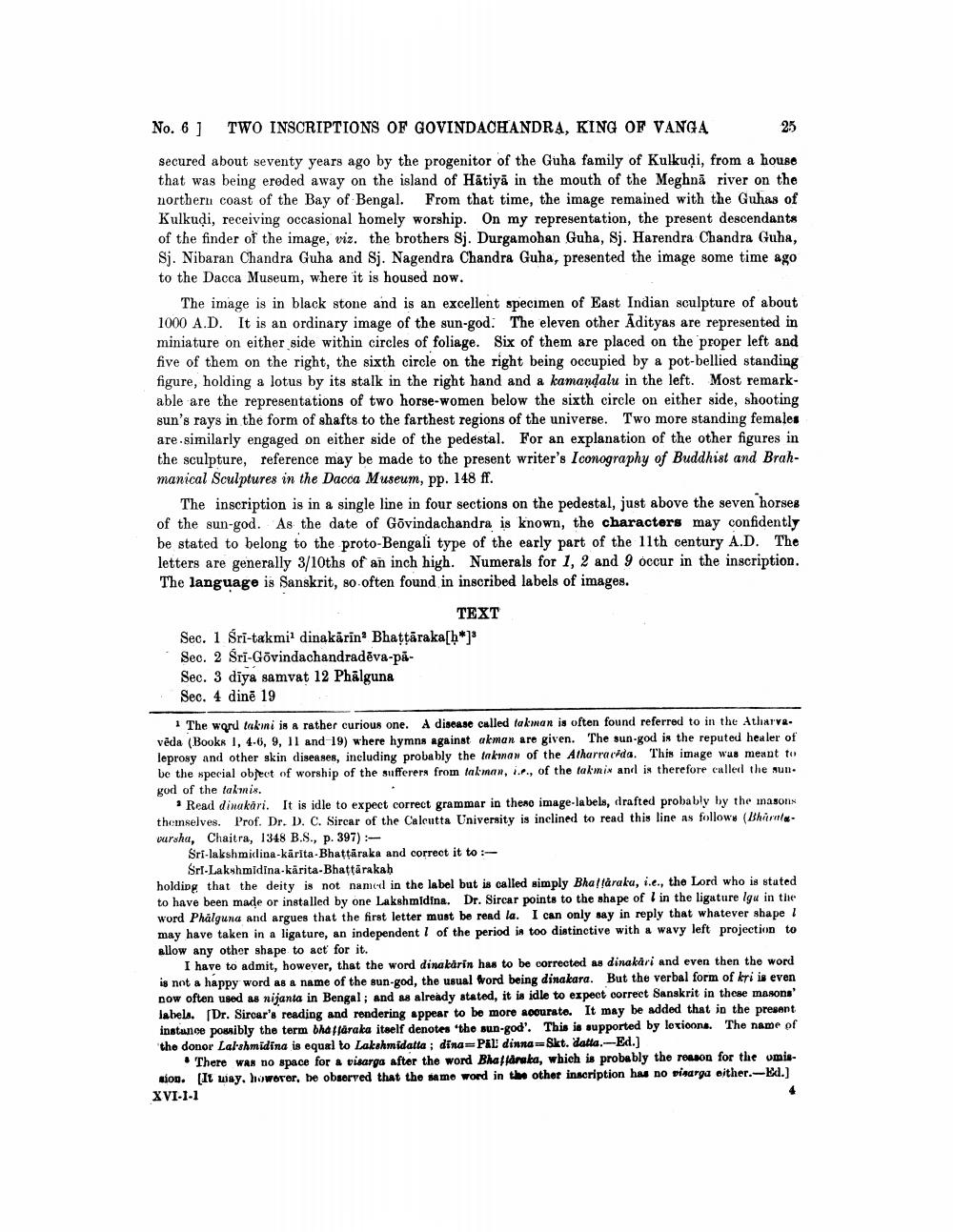________________
No. 6]
TWO INSCRIPTIONS OF GOVINDACHANDRA, KING OF VANGA
secured about seventy years ago by the progenitor of the Guha family of Kulkudi, from a house that was being eroded away on the island of Hätiya in the mouth of the Meghnā river on the northern coast of the Bay of Bengal. From that time, the image remained with the Guhas of Kulkuļi, receiving occasional homely worship. On my representation, the present descendants of the finder of the image, viz. the brothers Sj. Durgamohan Guha, Sj. Harendra Chandra Guha, Si. Nibaran Chandra Guha and Sj. Nagendra Chandra Guha, presented the image some time ago to the Dacca Museum, where it is housed now.
The image is in black stone and is an excellent specimen of East Indian sculpture of about 1000 A.D. It is an ordinary image of the sun-god: The eleven other Adityas are represented in miniature on either side within circles of foliage. Six of them are placed on the proper left and five of them on the right, the sixth circle on the right being occupied by a pot-bellied standing figure, holding a lotus by its stalk in the right hand and a kamandalu in the left. Most remarkable are the representations of two horse-women below the sixth circle on either side, shooting sun's rays in the form of shafts to the farthest regions of the universe. Two more standing females are similarly engaged on either side of the pedestal. For an explanation of the other figures in the sculpture, reference may be made to the present writer's Iconography of Buddhist and Brahmanical Sculptures in the Dacca Museum, pp. 148 ff.
The inscription is in a single line in four sections on the pedestal, just above the seven horses of the sun-god. As the date of Govindachandra is known, the characters may confidently be stated to belong to the proto-Bengali type of the early part of the 11th century A.D. The letters are generally 3/10ths of an inch high. Numerals for 1, 2 and 9 occur in the inscription. The language is Sanskrit, so often found in inscribed labels of images.
TEXT Sec. 1 Śri-takmi dinakärinBhatýāraka[h*]* Seo. 2 Sri-Govindachandradēva-paSec. 3 diya samvat 12 Phālguna Sec. 4 dinē 19
The word takmi is a rather curious one. A disease called takman is often found referred to in the Atharve. vēda (Books I, 4-6, 9, 11 and 19) where hymns against akman are given. The sun god is the reputed healer of leprosy and other skin diseases, including probably the takman of the Atharra da. This image wus meant to be the special object of worship of the sufferers from takman, i.e., of the takmin and is therefore called the sun. god of the takmis.
Read dinakari. It is idle to expect correct grammar in theao image-labels, drafted probably by the masons themselves. Prof. Dr. D. C. Sircar of the Calcutta University is inclined to read this line as follows (Bhimie pursha, Chaitra, 1348 B.S., p. 397) -
Sri-lakshmilina-kärita-Bhattaraka and correct it to
Sri-Lakshmidina-kärita-Bhattarakah holding that the deity is not named in the label but is called simply Bhaldraku, i.e., the Lord who is stated to have been made or installed by one Lakshmidina. Dr. Sircar points to the shape of l in the ligature Igu in the word Phålguna and argues that the first letter must be read la. I can only say in reply that whatever shape 1 may have taken in a ligature, an independent l of the period in too distinctive with a wavy left projection to allow any other shape to act for it.
I have to admit, however, that the word dinakarin has to be corrected as dinakari and even then the word is not a happy word as a name of the sun god, the usual word being dinakara. But the verbal form of kri is even now often used as nijanta in Bengal; and as already stated, it is idle to expect correct Sanskrit in these masons labela. [Dr. Sircar's reading and rendering appear to be more acourato. It may be added that in the present instance powsibly the term bhaffaraka itaelf denotes "the sun-god'. This is supported by lotions. The name of the donor Lalushmidina is equal to Lakshmidatta; dinasPal dinnaSkt. datta.Ed.)
. There was no space for a visarga after the word Bhaffäraka, which is probably the rouson for the umission. [It way, howorer, be observed that the same word in the other inscription has no vinarga either.- I.) XVI-1-1




